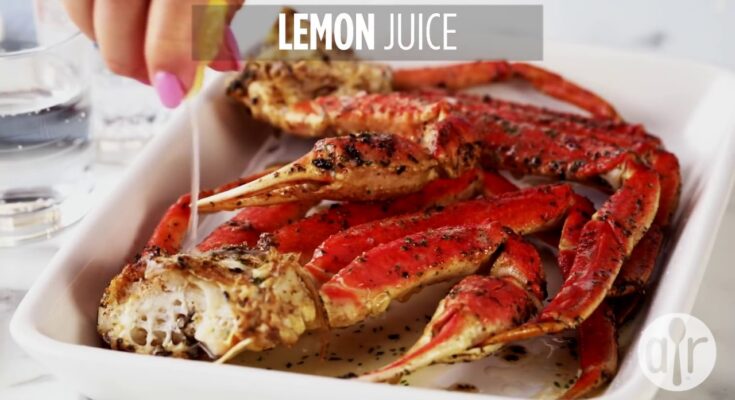Crab Legs Recipe: There’s something magical about digging into a plate of perfectly cooked crab legs. They’re a symbol of indulgence and luxury, often associated with seafood boils and coastal vacations. But here’s the good news—you don’t need to dine at an expensive seafood restaurant to enjoy them. With a little know-how and some kitchen essentials, you can prepare mouth-watering crab legs right at home.
Cooking crab legs might seem intimidating at first, but it’s actually simpler than you’d expect. Whether you’re planning a romantic dinner, hosting a party, or just craving some juicy seafood, this step-by-step guide will show you exactly how to prepare and cook crab legs like a pro. From choosing the right type of crab to mastering different cooking methods, we’ve got you covered. Let’s get cracking!
Choosing the Right Crab Legs
Selecting the right crab legs is crucial if you want to end up with a flavorful, succulent dish. But with a few varieties to choose from, which one should you go for?
Types of Crab Legs (King, Snow, Dungeness)
Crab legs come in a few main varieties, and each type has its own texture and flavor profile:
- King Crab Legs: Known for their massive size and sweet, rich flavor. They have a spiky shell and are typically more expensive due to their limited availability. Perfect for a luxurious meal.
- Snow Crab Legs: Smaller than king crab, but easier to handle and often more affordable. They have a slightly briny flavor and a more delicate texture.
- Dungeness Crab Legs: These have a slightly nutty, sweet flavor and a softer shell. They are more popular on the West Coast and often sold whole.
Each type brings something unique to the table, so consider your preferences and budget. For first-timers, snow crab is a great balance between flavor and ease of cooking.
Fresh vs. Frozen: What to Buy?
Crab legs are typically sold frozen, and that’s not a bad thing at all. Most crab is cooked and flash-frozen right on the boat to lock in freshness. So unless you’re living near the coast, frozen crab legs are your best bet.
Here’s what to look for:
- Frozen Crab Legs: Check the packaging for ice crystals or freezer burn. Avoid packages that seem damaged or overly frosty.
- Thawed or Fresh Crab Legs: If you’re buying them from a seafood counter, ask when they were thawed and how long they’ve been sitting.
Pro tip: Buy pre-cooked crab legs. Most legs in the market are already cooked—your job is just to reheat them properly.
Essential Ingredients and Tools
Let’s gather all the must-haves before diving into cooking. You don’t need a fancy setup, just the right basics.
Ingredients List for the Perfect Crab Legs Meal
You won’t need a long shopping list, but every ingredient here plays an important role in bringing out the flavors:
- 2 lbs of pre-cooked crab legs (King, Snow, or Dungeness)
- 4 tbsp of unsalted butter (for basting or dipping)
- 1 tbsp garlic (minced)
- 1 tsp lemon zest
- 1 lemon (cut into wedges)
- Optional: Old Bay seasoning, parsley for garnish, chili flakes for a kick
Want to make it a feast? Add corn on the cob, baby potatoes, and andouille sausage for a full seafood boil experience.
Kitchen Tools You’ll Need
Here’s what you’ll need in your kitchen arsenal to make this as smooth as possible:
- Large pot with lid (for boiling or steaming)
- Steamer basket (optional)
- Baking tray (for oven method)
- Tongs
- Crab crackers or nutcrackers
- Kitchen scissors (to cut through shells easily)
- Small saucepan (for melted butter sauce)
- Serving platter
If you’re feeling fancy, grab some seafood picks to get every last bit of meat out of the shell.
Preparing Crab Legs
Before you throw them in the pot or oven, proper prep is essential for flavor and texture.
Thawing Frozen Crab Legs Properly
Never cook crab legs straight from the freezer unless you’re boiling them in a rush (even then, it’s not ideal). Thawing ensures even cooking and better texture.
Here are two thawing methods:
- Overnight in the fridge: Place crab legs in a sealed bag or container and let them thaw in the refrigerator overnight. This is the safest and most effective method.
- Quick thaw in cold water: Place the crab legs (in a sealed bag) in a bowl of cold water for about 30 minutes to an hour. Do NOT use warm or hot water—it can affect texture and flavor.
Avoid microwaving to thaw. It can turn your beautiful crab meat rubbery and dry.
Cleaning and Trimming Tips
While crab legs are usually pre-cooked and clean, a quick rinse under cold water won’t hurt. It removes any ice glaze or residue. If you spot any brownish stuff or sand, wash it off gently.
Using kitchen scissors, cut any sharp tips or extra shell pieces that might get in the way while eating. For a more elegant presentation, cut slits in the shell for easier access to the meat. Trust me—your guests will thank you later.
Cooking Methods Explained
Crab legs are wonderfully versatile—you can cook them several different ways depending on your tools, taste, and time. Here are the most common and easiest methods for mouth-watering results every time.
Boiling Crab Legs
Boiling is the most traditional and foolproof method, especially for beginners. It keeps the meat juicy and enhances its natural briny sweetness.
Step-by-step:
- Fill a large pot with enough water to submerge the crab legs.
- Add a generous pinch of salt or Old Bay seasoning to the water for extra flavor.
- Bring the water to a rolling boil over high heat.
- Submerge the crab legs, reduce to medium heat, and boil for 5–7 minutes (if thawed), or up to 10 minutes (if frozen).
- Use tongs to remove them and place on a serving plate.
Boiled crab legs pair perfectly with garlic butter and lemon wedges. You can also add corn, potatoes, or sausage into the same pot for a one-pot seafood boil experience.
Pro Tip: Don’t over-boil. It can make the meat mushy or overly firm.
Steaming Crab Legs
Steaming is another fantastic method that retains more of the crab’s delicate, sweet flavor. It’s slightly more gentle than boiling, which helps prevent overcooking.
How to steam crab legs:
- Fill a large pot with 2–3 inches of water.
- Place a steamer basket or rack inside the pot to keep crab legs above the water line.
- Bring the water to a boil.
- Add the crab legs to the basket and cover the pot with a tight-fitting lid.
- Steam for 6–8 minutes, or until heated through.
You’ll know they’re done when you start smelling that unmistakable sweet seafood aroma.
Pro Tip: Add lemon slices, garlic cloves, or herbs to the steaming water for subtle infused flavors.
Baking or Grilling Crab Legs
If you love smoky, slightly charred flavors, baking or grilling crab legs will be your go-to.
Baking Instructions:
- Preheat your oven to 375°F (190°C).
- Place crab legs on a baking tray lined with foil.
- Brush with melted butter, garlic, and herbs.
- Cover with foil to keep the moisture in.
- Bake for 15–20 minutes until heated through.
Grilling Instructions:
- Preheat your grill to medium heat.
- Wrap the crab legs in foil with butter and herbs.
- Grill for 10–12 minutes, turning halfway through.
Both methods give you that irresistible buttery caramelization. If you’re entertaining or want to impress, grilled crab legs with smoky butter is an unforgettable treat.
Serving Suggestions and Side Dishes
Crab legs may be the star, but the right sides and sauces make the meal shine brighter. Think of it like pairing the right accessories with a stunning outfit.
Best Side Dishes for Crab Legs
- Garlic butter pasta: Simple, savory, and a perfect match for crab’s sweetness.
- Corn on the cob: A seafood boil staple.
- Roasted or mashed potatoes: Soak up all that delicious butter.
- Coleslaw: Adds a crunchy, tangy contrast.
- Crusty bread or dinner rolls: For scooping up every last drop of sauce.
If you’re keeping things low-carb, a crisp Caesar salad or grilled asparagus are great companions too.
Dipping Sauces That Elevate Flavor
- Garlic Lemon Butter: Melt butter with minced garlic, lemon juice, and a pinch of salt.
- Spicy Aioli: Mayo, garlic, lemon, and sriracha for heat.
- Cocktail Sauce: A tangy classic made from ketchup, horseradish, and lemon juice.
- Miso Butter: Adds a deep umami flavor to contrast the sweetness of the crab.
Presentation matters too—serve everything on a large platter, sprinkle with chopped parsley, and garnish with lemon wedges.
Tips for Eating Crab Legs Like a Pro
Now that your crab legs are hot and ready, it’s time for the fun (and sometimes messy) part: eating them! If you’ve never tackled crab legs before, here’s a quick tutorial on how to do it without frustration.
Tools That Make It Easier
- Crab crackers or nutcrackers: To crack through the hard shells.
- Seafood forks or picks: Helps extract meat from narrow leg segments.
- Kitchen scissors: Great for cutting through shells with minimal mess.
Step-by-Step Eating Guide
- Break the leg at the joint using your hands or scissors.
- Use a cracker to gently crack the shell along the length of the leg.
- Pull the shell apart and slide out the meat using a fork or your fingers.
- Dip into your preferred sauce and enjoy!
Pro tip: Don’t forget the knuckle meat—some of the sweetest and juiciest crab meat hides there!
Storing and Reheating Leftover Crab Legs
So, you’ve feasted and find yourself with leftover crab legs—lucky you! But how do you store them properly and bring them back to life without turning them rubbery or dry?
Proper Storage Methods
To keep your crab legs fresh and safe for the next day:
- Refrigeration: Place any leftover crab legs in an airtight container or tightly wrapped in aluminum foil or plastic wrap. Store in the coldest part of your refrigerator for up to 2–3 days.
- Freezing: For longer storage, wrap crab legs tightly in foil or vacuum-seal bags and freeze. They can be stored in the freezer for up to 2–3 months. Label the bags with the date to keep track.
Pro tip: Always refrigerate or freeze leftovers within two hours of cooking to prevent bacterial growth.
How to Reheat Without Overcooking
When reheating, the key is to retain moisture so the crab meat stays tender and juicy.
Best Reheating Methods:
- Steaming: Place crab legs in a steamer basket over boiling water for 5–7 minutes.
- Oven: Wrap them in foil with a splash of water or butter, bake at 350°F (175°C) for 10–15 minutes.
- Microwave: Place crab legs in a microwave-safe dish with a damp paper towel. Microwave for 1–2 minutes, checking frequently.
Avoid using high heat, especially in the microwave, to prevent overcooking the delicate crab meat.
Crab Legs for Special Occasions
Crab legs aren’t just food—they’re a celebration on a plate. Perfect for holidays, date nights, or any time you want to treat yourself or loved ones.
Holiday Feasts and Seafood Boils
Many families are ditching traditional turkey or ham for a seafood spread—and why not? Crab legs bring a festive flair that’s hard to beat.
Create a stunning seafood table with:
- Steamed crab legs
- Jumbo shrimp
- Mussels
- Corn, potatoes, and sausage
- Crusty bread and butter dips
Sprinkle some newspaper on the table, dump the feast in the center, and let everyone dig in with their hands. No plates, no problem!
Romantic Dinners or Family Nights
Want to impress your partner? Light some candles, steam some crab legs, and serve with wine and pasta. It’s a luxurious yet intimate meal that says, “I put in the effort.”
Got kids or a big family? Set up a “build your own seafood plate” night. Everyone gets hands-on, and dinner becomes an interactive event.
Crab Leg Recipe Variations
Crab legs don’t have to be served the same way every time. You can add your own twist and turn this classic into a new dish each time.
Garlic Butter Crab Legs in Foil
Wrap thawed crab legs in foil with butter, garlic, parsley, and a dash of white wine. Bake at 400°F (200°C) for 15–20 minutes. The foil traps all the buttery, garlicky steam—flavor explosion guaranteed!
Spicy Cajun Crab Legs
Add a bold Southern twist:
- Mix melted butter with Cajun seasoning, garlic, lemon juice, and a hint of smoked paprika.
- Drizzle over crab legs and bake or grill for a spicy kick.
- Serve with cornbread or dirty rice.
Asian-Inspired Crab Legs
Want something different?
- Steam the crab legs and serve with soy sauce, sesame oil, ginger, and scallions.
- Add a dash of chili oil for heat.
This version is lighter but packed with umami flavor and works great with jasmine rice.
Common Mistakes to Avoid
Cooking crab legs isn’t hard, but there are a few traps to avoid if you want that perfect, restaurant-style result.
Overcooking the Crab Legs
Crab legs are usually pre-cooked when you buy them, so your goal is to reheat—not recook. Boiling or baking for too long can dry out the meat and ruin the texture.
Fix: Set a timer. Less is more!
Skipping the Butter Sauce
No matter how you cook your crab legs, skipping the butter is like forgetting the popcorn at the movies. Garlic lemon butter brings out the crab’s natural sweetness and adds a luxurious finish.
Fix: Always serve a dipping sauce. Always.
Not Cracking the Shell Properly
Shells can be tricky, especially if you don’t have the right tools. Banging them with a hammer or your teeth isn’t just messy—it’s dangerous.
Fix: Use kitchen shears or proper crab crackers to neatly open shells without smashing the meat.
FAQs about Crab Legs Recipe
Q1: What’s the best way to cook crab legs at home?
The most popular methods are boiling, steaming, baking, or grilling. Boiling is quick and easy, while steaming helps retain more flavor. Baking and grilling are perfect for adding buttery or seasoned finishes.
Q2: Do I need to thaw frozen crab legs before cooking?
Yes, for best results, thaw them in the refrigerator overnight. This ensures even cooking and prevents the meat from becoming rubbery.
Q3: How long should I cook crab legs?
Typically, crab legs take about 5–7 minutes to cook once thawed. If you’re using frozen ones directly, extend the cooking time by a few minutes.
Q4: How can I tell when crab legs are done?
They’re fully cooked when the shells turn bright orange-red and the meat is hot throughout. Since most sold crab legs are pre-cooked, you’re mainly reheating them.
Q5: What’s the best seasoning for crab legs?
Classic Old Bay seasoning, garlic butter, lemon pepper, and Cajun spice blends are all excellent choices. A simple melted butter dip also enhances the natural sweetness of the crab.
Q6: Can I reheat leftover crab legs?
Absolutely. Reheat gently by steaming, baking, or microwaving with a damp paper towel to keep them moist.
Q7: Are crab legs healthy?
Yes! They’re high in lean protein, low in fat, and a good source of omega-3 fatty acids, vitamin B12, and minerals like zinc and selenium.
Q8: What’s the easiest way to crack crab legs?
Use a crab cracker or kitchen shears to snip along the leg’s shell, then gently pull out the meat. A nutcracker or even the back of a spoon can also work in a pinch.
Q9: How should I serve crab legs?
They pair well with melted butter, lemon wedges, corn on the cob, baked potatoes, or a side of garlic bread. They’re also great in salads, pastas, and soups.
Q10: Can I freeze leftover crab legs?
Yes, store them in an airtight container or freezer bag for up to 2–3 months. For best flavor, consume sooner rather than later.
Conclusion
Cooking crab legs at home might seem like a culinary challenge, but once you know the basics, it becomes one of the most rewarding seafood dishes you can make. Whether you steam them with lemon and garlic, bake them in foil with spices, or grill them for a smoky flavor, crab legs are versatile, delicious, and always impressive.
With the right prep, tools, and a little attention to detail, you can turn any night into a feast. So the next time you walk past those frozen crab legs at the store, don’t hesitate. Grab them, get cooking, and enjoy the flavor of the ocean in your own kitchen.



